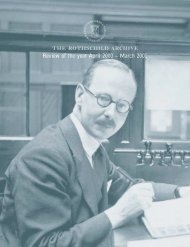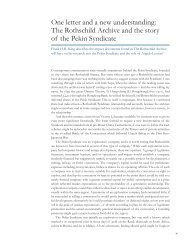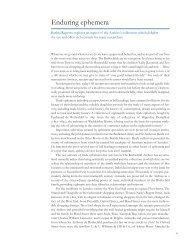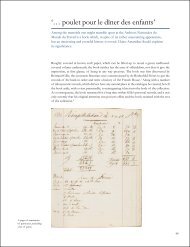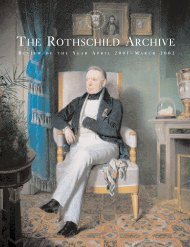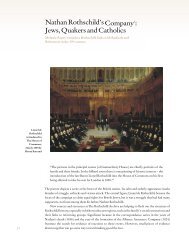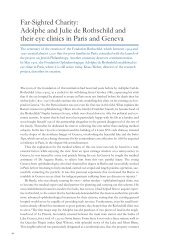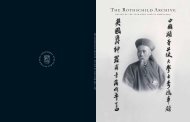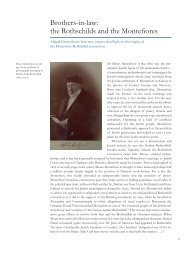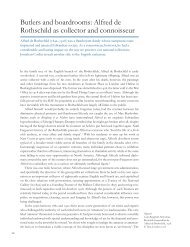66900 Rothschild Archive - The Rothschild Archive.
66900 Rothschild Archive - The Rothschild Archive.
66900 Rothschild Archive - The Rothschild Archive.
You also want an ePaper? Increase the reach of your titles
YUMPU automatically turns print PDFs into web optimized ePapers that Google loves.
Egyptian finances in the nineteenth<br />
century: a <strong>Rothschild</strong> perspective<br />
Caroline Shaw reveals new sources for the history of Egyptian finances in<br />
<strong>The</strong> <strong>Rothschild</strong> <strong>Archive</strong>.<br />
One of the great pleasures of working in an archive is the sudden sensation of discovery, of<br />
emerging into a new landscape, that opening a brown cardboard box – even a well-labelled<br />
cardboard box – can sometimes yield. Just such a moment occurred when I was researching the<br />
<strong>Archive</strong>’s latest publication <strong>The</strong> Necessary Security: an illustrated history of <strong>Rothschild</strong> bonds and discovered<br />
not only extensive documentation for a largely forgotten bond issue but a vivid and<br />
moving correspondence from the era of British imperialism.<br />
<strong>The</strong> bond certificate issued for the three per cent £9,000,000 loan to Egypt in 1887 initially<br />
attracted my attention for no better reason than its lively vignettes and decorative panels executed<br />
in a very European interpretation of Egyptian themes and styles. <strong>The</strong> loan itself was of<br />
interest for it was guaranteed by all the great European powers – Germany, Austria-Hungary,<br />
France, Great Britain, Italy and France – as Egyptian finances were a sensitive international subject<br />
in the latter quarter of the nineteenth century. As so often one bond led to another, in this<br />
case to the first Egyptian bond issued by the <strong>Rothschild</strong> banks, the 1879 five per cent £8,500,00<br />
Egyptian state domain mortgage loan.<br />
<strong>The</strong> bond certificate for the 1879 loan was not so immediately appealing, and the only<br />
example in the <strong>Archive</strong> had been heavily perforated by the bank’s industrially-proportioned<br />
cancelling equipment, yet it was to prove to be a ticket to uncharted territories. <strong>The</strong>re were a<br />
number of clues that this loan had been more than a little out of the ordinary: documents had<br />
not been filed in the usual series; ₁ there was considerably greater documentation than usual for<br />
a loan of that date; and at some point the documents had passed through the hands of NM<br />
<strong>Rothschild</strong> & Sons’ solicitors, who had sorted them into neat bundles. This had clearly been a<br />
contentious transaction.<br />
<strong>The</strong> Khedive of Egypt, Ismail Pasha, had had great ambitions for his reign (1863–1879):<br />
irrigation works, bridges, sugar mills, docks and harbours, railways and a stake in the Suez<br />
Canal. But he borrowed – and was lent – money recklessly: Egypt became heavily indebted and<br />
its population of largely agricultural labourers bore a tremendous burden of taxation. <strong>The</strong><br />
European bondholders, concerned that Egypt would be unable to meet its obligations to them,<br />
put pressure on their governments to intervene. In 1878 Ismail Pasha was compelled to accept<br />
an external commission of enquiry, and in August of that year the British and French commissioners<br />
were appointed to his cabinet. By then Egypt was on the very verge of bankruptcy, without<br />
sufficient funds to pay the dividends on its consolidated debt. Charles Rivers Wilson, now<br />
the Khedive’s Minister of Finance, approached Lionel de <strong>Rothschild</strong> with a proposal for a loan<br />
secured on the property of the Khedive and his family. Over the course of his reign these<br />
estates had grown to encompass around one fifth of Egypt’s agricultural land: Rivers Wilson<br />
further proposed that their revenue be used to service the loan.<br />
Lionel was, of course, famously responsible for providing the money in 1875 for the British<br />
government to purchase the Khedive’s shares in the Suez Canal.² Receipts of that date, found<br />
in the <strong>Archive</strong>, suggest that the bank then immediately used the proceeds of this sale to liquidate<br />
some of the Khedive’s debts to a number of other banks. <strong>The</strong> <strong>Rothschild</strong> banks had not,<br />
however, had any prior involvement in handling loans for Egypt and it is perhaps surprising that<br />
Monogram of Ismail Pasha,<br />
from correspondence<br />
addressed to James and<br />
Betty de <strong>Rothschild</strong>.<br />
34



